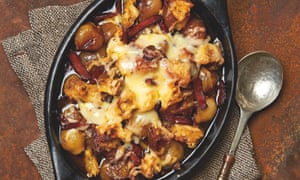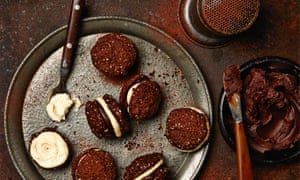
Yotam Ottolenghi’s French onion soup gratin. Photograph: Louise Hagger for the Guardian. Food styling: Emily Kydd.
Acouple of weeks ago, in Weekend’s winter food special, I argued that this Christmas we should let vegetables rule the roost. But if you’d rather have a bit of everything on the table, it’s fun to set those virtuous plates alongside others that are monumentally rich. Well, Christmas is meant to be a time to make room for all, isn’t it?
Contents
French onion soup gratin
Yes, there are a lot of baby onions in this, but peeling them is a job that can be easily outsourced at this time of year, when there are often people in or near the kitchen looking to be of use. It also helps to pour boiling water over the onions, leave them to soak for a few minutes, then drain and peel. Serves six.
40g unsalted butter
2 tbsp olive oil
1.2kg mixed baby onions (shallots, pearl, etc), peeled (1kg net weight)
¼ tsp black peppercorns, lightly crushed
Salt
3 slices smoky bacon, cut into 1cm-wide strips
½ tsp caster sugar
150ml dry white vermouth
2 tbsp brandy
15g sage sprigs and 10g thyme sprigs, tied together with string
500ml beef stock
90g gruyère, coarsely grated
For the mustard croutons
100g sourdough, crust on, torn into rough 1.5cm pieces
2 garlic cloves, peeled
2 tbsp olive oil
2 tbsp Dijon mustard
Heat the oven to 180C/350F/gas mark 4. Mix all the ingredients for the croutons, then spread them out on a large oven tray lined with baking paper, spacing them well apart. Bake for 10-12 minutes, until golden brown and crisp, then leave to cool.
Put the butter and oil in a large saute pan on a medium-high heat. Once the butter is foaming, add the onions, crushed pepper and three-quarters of a teaspoon of salt. Fry for 12-15 minutes, adding the bacon after five minutes. Stir a few times while the onions are cooking, until they are soft and caramelised, and the bacon is crisp. Add the sugar, vermouth and brandy, cook for three minutes to reduce, then turn the heat to medium. Add the sage and thyme, pour in the stock, cover, and simmer for 15 minutes, until the onions are very soft. Remove the lid, turn the temperature up high and cook rapidly for eight to 10 minutes, until the sauce is syrupy.
Discard the sage and thyme bundle, then tip the soup into a 17cm x 22cm gratin dish. Dot all over with the croutons and sprinkle the cheese on top, then bake until the surface is bubbling and caramelised, about 10 minutes; if the cheese could do with a bit more colour, put the dish briefly under a hot grill. Set aside to cool for five minutes, then serve.
Confit duck legs with slow-cooked red cabbage and pears
The classic combo of duck and red cabbage, with a bit of a twist. Serves four.
4 duck legs
Flaky sea salt and black pepper
1 red cabbage, cored and cut into 8 wedges
4 williams pears, peeled
100ml red wine
150ml chicken stock
15g thyme sprigs
2-3 tsp juniper berries
7 star anise
1½ tbsp dark brown sugar
40g unsalted butter
2 tbsp red-wine vinegar
500g duck or goose fat
Put the duck in a glass bowl with 50g of flaky sea salt. Mix well to coat the duck evenly, then cover the bowl and set aside for at least four hours, preferably overnight.
Heat the oven to 170C/335F/gas mark 3. Put the cabbage wedges in a high-sided, 20cm x 30cm baking tray. Use a corer, if you have one, to remove the pears’ cores from the base, so you keep the tops intact; otherwise, use a small serrated knife to cut a 3cm-wide circle around the centre of the base of each pear, then carefully cut up into the core to remove the seeds and pith while keeping the pears more or less whole. Add the pears to the cabbage tray.
Pour the wine and stock into a small saucepan with 5g thyme, half a teaspoon of juniper berries, five star anise and a tablespoon of brown sugar. Stir in the butter, vinegar, a teaspoon and a half of salt and plenty of pepper. Bring to a boil, then pour over the cabbage and pears. Cover the tray with foil and bake for two hours; after an hour, turn the pears and cabbage. Remove the foil and bake for another 45 minutes, again basting and turning halfway through.
Use a large slotted spoon to transfer the pears and cabbage to a large plate or bowl, and cover to keep warm. Strain the liquid into a small saucepan, discarding the spices, then bring to a boil and leave to bubble away for three to five minutes, until the sauce reduces and thickens, then set aside.
The moment the cabbage and pears are in the oven, get started on the duck. Rinse off the salt, pat the legs dry and put them in a medium-sized, round cast-iron pot for which you have a lid. Add the fat, the rest of the thyme and a teaspoon of juniper berries, then put on a high heat. Once the fat has melted and is starting to bubble, cover and roast alongside the pears and cabbage for two and a half hours, until the duck is very tender and almost falling off the bone. Transfer the duck to a medium baking tray.
Put a teaspoon of juniper berries, two star anise and a teaspoon and a half of sugar in a spice or coffee grinder. Blitz until smooth, then sprinkle the spice mix over the duck legs and set aside; keep them warm if the cabbage isn’t quite ready.
To serve, gently reheat the pan of cabbage sauce and set the grill to its highest setting. Grill the duck legs in the middle of the oven for three to four minutes, until the skin is crisp and the sugar has caramelised. Serve one duck leg per portion, with two wedges of cabbage and a pear alongside. Spoon over some sauce and serve.
Chocolate and sesame yo-yos

Yotam Ottolenghi’s chocolate and sesame yo-yos. Photograph: Louise Hagger for the Guardian. Food styling: Emily Kydd.
You need to make the ganache a day or two before serving, and keep it at room temperature rather than in the fridge, where it will set too hard to spread; you can make the other two components ahead as well, ready to be put together on the day. You can also make just the biscuits, without the cheesecake filling and ganache; if you do so, dust them with cocoa and serve with a cup of tea. Makes 12.
60g plain flour
½ tsp baking powder
10g cocoa, plus ½ tsp extra to dust
80g sesame seeds, toasted until golden brown and set aside until cool
¼ tsp salt
70g unsalted butter, softened
60g light brown sugar
1 egg, whisked
½ tsp vanilla extract
80g 70% dark chocolate, melted
For the cheesecake
130g mascarpone
40g tahini paste
25g icing sugar, sifted
For the chocolate ganache
70g 70% dark chocolate, chopped
25g unsalted butter
75ml double cream
First make the ganache. Put the chocolate and butter in a heatproof bowl. Heat the cream in a saucepan until it just comes to a boil, then pour over the chocolate and stir until melted and smooth. Cover the surface of the ganache with clingfilm and leave overnight at room temperature, to cool and set.
Heat the oven to 180C/350F/gas mark 4. To make the biscuits, sift the flour, baking powder and cocoa into a bowl. Add the cooled sesame seeds and salt, and stir. In a second bowl, mix the butter and sugar by hand until just incorporated, then add the egg, vanilla extract and chocolate, and mix until smooth.
Tip all the dry ingredients into the bowl and mix to combine. Using two teaspoons, form 2cm-wide balls of the mixture and space these out well on two large oven trays lined with baking paper.
Bake the biscuits for six minutes, until just cooked, then leave to cool on the trays for five minutes before transferring to a wire rack and leaving to cool completely. Meanwhile, mix all the cheesecake ingredients in a bowl until smooth, then set aside.
To assemble the yo-yos, spread a generous teaspoon of cheesecake mix on one side of half the cookies and a generous teaspoon of ganache on one side of the other cookies (two piping bags would come in handy). Sandwich the two together, so the ganache and cheesecake meet in the middle, then arrange on a plate, dust with cocoa and serve.
[Source:-the gurdian]
